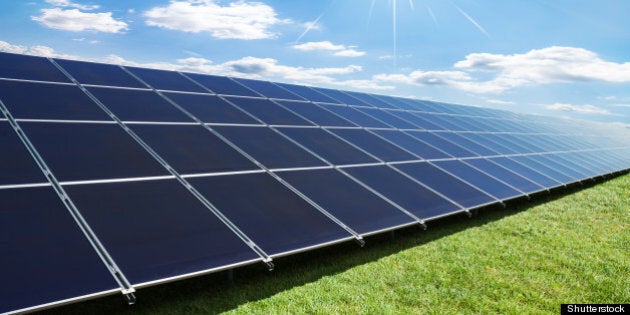
Entrepreneurs, inventors and researchers all over the world are beavering away, trying to find an answer to a multi-billion dollar question: How do you cheaply and reliably store energy for the grid?
Due to the intermittent nature of solar and wind power energy storage is key to integrating more and more renewables onto the grid. And the trend is clear -- prices for renewable energy technology are dropping and more and more policy is coming online that encourages renewable energy development. Grid operators need stability and they're willing to pay. Lux Research just released a report, which finds that grid storage demand will expand to $10.4 billion by 2017.
Energy storage is going to be part of new, smarter, more flexible grids. Short-term storage can help balance the ebbs and flows of electricity in the grid, it will increase the amount of renewable energy that can go on the grid from 20 to 50 per cent or higher, it will work well with increasing numbers of electric cars and it can even help utilities defer investments in very expensive infrastructure by making the grid more efficient.
In Canada we've got many entrepreneurs working on figuring out energy storage. Cam Carver is the CEO of Temporal Power, an energy storage startup based in Mississauga, Ontario. They're taking an idea that Da Vinci himself worked on, the flywheel, and scaling it up for commercial use.
"A flywheel is essentially a mechanical battery that stores kinetic energy, and what we're doing is we're storing energy in a very heavy, fast-spinning wheel of solid steel," says Carver.
It sounds complicated but think of a flywheel like a game of tether-ball (thanks to Cleantechnica for the analogy). In tether-ball you infrequently provide large bursts of energy to swing the rope and the ball around the pole. The weight of the rope and ball combine to even out the bursts of energy, giving it a relatively constant motion around the pole. But the rope stores energy as well and after it fully wraps around the pole the ball reverses its direction at a relatively steady pace without any further energy input from the players.
When the sun is out or the wind is blowing the flywheel is spinning up, charging the battery so to speak. When energy is needed it slows down releasing the stored up kinetic energy.
The flywheel at Temporal started out in the garage of Jeff Veltri, the company's co-founder and current CTO. They've since scaled that table-top version up three times to the one we saw in their warehouse, a seven-foot tall, 9,000-pound solid steel flywheel that is suspended by magnets in a vacuum to reduce friction. It can store the equivalent of 50 kilowatt hours of electricity.
Temporal is also working on two pilot projects, one with NRStor to counter-balance short-term voltage variations, the other is a five megawatt storage plant that will go in near Tillsonburg, an area rife with wind development and the location of the Siemens plant that shipped the first made-in-Canada wind turbines. These two projects show the versatility of the flywheel as the Ontario Power Generation project works on a minute-to-minute basis while the five megawatt project works on a longer timeframe.
"This is part of the magic pill. This helps solve a very important and immediate part of the problem," says Carver.
Community Energy Storage
The next company we tracked down in the energy storage space features a product that the great majority of us carry around every day -- a lithium-ion battery, like the one in your cell phone.
The company is called eCAMION and the project we checked out is called Community Energy Storage. It's a giant lithium-ion battery with 1,700 separate cells and enough juice to keep a modest sized neighborhood running for a couple of hours. It's tucked in a non-descript green box near the Roding Arena and Community Centre in North York.
Carmine Pizzurro of eCAMION describes it as a shock absorber for the grid. It interacts dynamically with the grid, storing energy when it's abundant, releasing energy when it's needed.
"It's an excellent way to make your grid more efficient, not only does it peak shave, but because it's coupled with renewables it's a more efficient use of electricity on the grid. You can use the battery source as energy to make the whole grid more efficient and more useful for the utilities," says Pizzurro.
Peak shaving, valley filling, load shifting. This isn't the latest in technology from Gillette these are real, day-to-day concerns for grid operators and it ultimately affects how much your electricity bill ends up costing you.
Typically when the grid needs energy they fire up what's called a peaker plant. They usually run on natural gas and when they're needed they cost a pretty penny. Not only can battery projects like this mitigate the need to run these peaker plants, but they improve power quality and help make existing grid assets long longer.
This is the first time the idea has been tested on a grid-scale in Canada, which was kind of the point of the $16 million project which received a $5 million grant from Sustainable Development Technology Canada.
And Pizzurro has quite a pedigree when it comes to battery technology. He ran a battery plant for GM for eight years and was a part of the Chevy Volt's battery program.
"So the amount of experience I have with batteries is pretty good and what we wanted to do was to utilize that experience and give it to the utility grid because there is a huge need for battery storage on the energy grid," says Pizzurro.
The initial Community Energy Storage project was commissioned earlier in 2013 and two more will be built.
Batteries Included
These were just the two energy storage companies we visited but projects like these are happening everywhere. Different flywheels are getting built. Battery storage technology is being integrated into projects around the world such as this 5 megawatt project near Portland. Companies are developing large batteries to go with wind turbines or going even bigger and attaching a large battery farm to a large wind project.
Sustainable Energy Technologies in Calgary is developing inverters for home-based solar systems in Germany which are integrating a battery. They then sell the power back to the grid when the sun isn't shining so brightly in order to make more money.
As project after project succeeds or fails, the level of knowledge will increase and the engineering culture at the utilities and grid operators will gradually shift. There are clever, ambitious people out there doing exciting things, and with a $10 billion-dollar prize you can rest assured that someone will figure it out.
